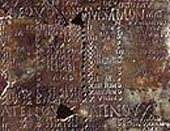Although the Roman conquest caused the Gaulish language to disappear 2,000 years ago, some remaining bilingual Gaulish/Latin inscriptions still allow scholars to trace the origins of Celtic and many other European languages.
 |
|
One of the rare Gaulish inscriptions. |
According to their research, Celtic is divided into two branches from a Proto-Indo-European language that dates back to 3,200 BCE. One version—Gaulish, also known as Continental Celtic—was used on the European continent. The second version, known as Insular Celtic, arrived directly in England.
Within England, Celtic is further subdivided into Brythonic (Welsh or Breton Celtic) and Goidelic, known as Irish and Scottish Gaelic.
This single wave of migration to England contradicts a previous hypothesis that Celtic arrived in England through two events, one of which brought Celtic directly to Ireland. Researchers have also pinpointed the emergence of the Proto-Indo-European language, which has since disappeared, to around 8,100 BCE.
To support this, Peter Forster from the University of Cambridge applied DNA analysis methods to study the inscriptions and corresponding words from Ancient Greek, Old Irish, and modern versions of Irish, Welsh, Breton, French, Spanish, and more.
Most words across these languages are relatively similar. For instance, the word for mother in Gaulish is matir, while in Latin it is mater. These similarities are linked to changes in genetic inheritance. However, another group of words is entirely different. For example, the word for daughter in Gaulish is duxtir, while in Spanish it is hija. These differences are likened to newly emerging genes that replace the old ones. This allows researchers to determine the timeline for the emergence of languages, similar to how one traces the origins of a new species based on DNA.
“The findings confirm that our language was brought to Europe and the British Isles by the first farmers during the early Neolithic period. These farmers may have come from the Near East, passing through Turkey,” Forster stated.
Experts hope that many ancient languages beyond Gaulish and Latin, such as Hittite, can also be used to study the origins of Celtic and many other European languages.
Minh Thi

















































